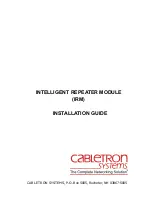
Page 33
CABINET HEATER
4.2
Electrical Supply
A 230 volt 50 Hz single phase supply is required for all heater Models 015 to 030 connected to the heater terminals L
1,
N & Earth.
Standard models 040 to 0100, and all High Flow models require a 400 volt 50 Hz three phase and neutral supply
connected to the heater terminals L
1
, L
2
,L
3
, N, and Earth.
All heaters and controls must be correctly earthed. All external wiring must comply with the relevant IEE and local
regulations and be carried out by a qualified electrician.
It is important that "L & N" polarity is correct for these heaters as incorrect polarity may prevent the burner control box
from operating properly. It is also important that the voltage between N and earth is at 0v and can never exceed 15v.
Note:
Roberts-Gordon can supply a special isolating transformer to provide a suitable treatment of the supply to the
burner, where there is a problem on the electrical supply with respect to voltage between N and Earth.
An isolator with a contact separation of at least 3 mm on all poles should be installed adjacent to the heater, but not
attached to it, to disconnect all supplies to the heater and where necessary to isolate the remote control panel.
The final connection to the heater should be made in metal sleeved flexible cable or flexible conduit to the main
terminal block under the front lower panel of the heater using 1 sq. mm cable on all models (except Model 0100 and
High Flow models with 5.5kW or 7.5kW motors) when 1.5 sq. mm cable should be used. Cable entry is provided into
the rear horizontal frame of the cabinet.
4.3
Remote Controls
4.3.1
Individual Controls
All the heater controls for the COMBAT® range are to be site wired remote from the heater. The minimum control would
be a room temperature control thermostat wired between terminals 2 and 3 of the heater. Extra controls will be required
for burners with High.Low or Modulating operatein see 4.3.1.1
All controls must be voltage free from external sources.
Where a time switch and/or manual switch are installed then these should be wired in series with the control thermostat.
Siting of Thermostats or Temperature Sensors
When siting a remote control thermostat or temperature sensor it should be fitted on a wall or column at a height of
1.5m from the floor of the room being heated.
It is important for comfort and fuel economy to site the thermostat where it will monitor an average room temperature
i.e. keep clear of draughts from doors or windows or from the direct path of heated air from the heater. Areas of little air
movement, e.g. corners, should also be avoided.
Where a remote Frost Thermostat is being used, it should be sited within the heated space adjacent to the most
vulnerable equipment that requires protection.
Содержание Combat HF 30 v4
Страница 2: ......
Страница 47: ...Page 45 CABINET HEATER Section 6 Wiring Diagrams Fig 6 1 As Wired Diagram for Models 015 to 030 Floor Standing ...
Страница 48: ...Page 46 CABINET HEATER Fig 6 2 As Wired Diagram for Models 015 to 030 Horizontal Mounting ...
Страница 49: ...Page 47 CABINET HEATER Fig 6 3 As Wired Diagram for Models 040 and 050 Floor Standing ...
Страница 50: ...Page 48 CABINET HEATER Fig 6 4 As Wired Diagram for Models 040 050 Horizontal Mounting ...
Страница 51: ...Page 49 CABINET HEATER Fig 6 5 As Wired Diagram for Models 060 to 0100 Floor Standing ...
Страница 52: ...Page 50 CABINET HEATER Fig 6 6 As Wired Diagram for Models 060 to 0100 Horizontal Mounting ...
Страница 55: ...Page 55 CABINET HEATER Fig 6 12 Wiring Diagram for High Flow Models HF40 v3 HF50 v2 HF50 v3 and HF50 v4 ...
















































